| |
|
Architecture and Interiors at Rockelstad
We take a deeper look into the architecture and style of the houses and
most important interiors.
The Castle Exterior
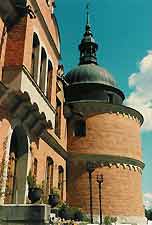
Facade in perspective
|
This small castle of brick and sandstone is a remarkable creation that leaves few
visitors untouched. The yard-side is dominated by the sturdy round towers with
their copper-clad domed roofs and elaborate spires.
On the centre of the face is a protruding section above the arched main entrance,
and the upper floor windows are marked with decorative barocko blind-towers. It
gives a balanced, if naïve, impression, and the well-informed visitor will recognize
the architecture popular around 1890. But a closer look reveals that the building is
slightly asymmetrical, which hints that this is a much older house.
|
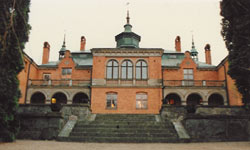
Lake facade in close-up
|
The lake-side is fundamentally different from the yard-side, with arcades of sandstone
that bind together the towers at each end with the protruding centre-section; at this
side everything is strictly symmetrical. Rockelstad is a romantic fortress on the
south side, but an Italian-inspired renaissance palace in on its north side.
|
Visitors to Rockelstad inevitably ask "when is the castle built?" The truth is that this
castle, like so many other old houses, does not have a specific building-date, but is the
remainder of changes made by each generation through history. During the 1700th century
the owners, the Stuart family, replaced the previous medieval houses, the appearance of
which we can only guess, with the typical barocco layout of buildings: A central mansion
and four separate wings in pairs along a line of symmetry, forming a court-yard.
The mansion itself is probably built as early as 1642, but the whole
complex was not complete until mid 1800th century. Similar estates
exist throughout central Sweden,
some of which are preserved intact today. Up until 1889 Rockelstad Estate had a
1700th century complex of buildings made of timber, with a central
building of about 600 m2, two larger wings of nearly 400 m2 each and two
smaller wings. The main building did not have a full upper floor, the slated
roof lay directly on top of the bottom floor. All houses had been altered
slightly when new owners took over around 1795, to match current fashion
inspired from the temples of antiquity, its faces made to look like stone. Most
likely the buildings were painted in yellow ochre with whitewashed pilasters
and brownish red windows.
The greatest external
change occurred in 1890, when the owner Carl Sylvan had four monumental
corner-towers added to the rectangular mansion. Today such a rebuilding of an
old house would be considered an act of barbaric madness, but at that time
there was no such respect of old age. Instead the mode-de-temps was focusing on
the 16th century royal castles, particularly those built by the
first king of unified Sweden, Gustav Vasa, and the greatest among them, Gripsholm Castle.
The Romantic
Era during the fist half of the 1900th century had evolved into a national
romanticism, and the architects were inspired by such houses they believed to
exhibit a genuine Swedish character. This culminated in the great renovation of
Gripsholm Castle, which was performed according to a proposal by Fredrik
Lilljekvist in 1887, aiming to restore the ancient Vasa-floor and the castle
exterior to its original appearance.
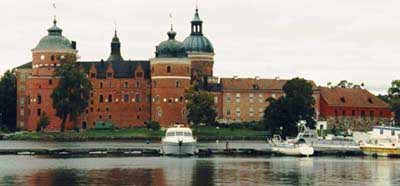
Vasafortress of Gripsholm
The Sylvan transformation of Rockelstad was blue-printed at the office of
Isaac-Gustav Claeson in Stockholm, the most noted architect at that time.
The old rooms of the house were left more or less unchanged, and only the
front round towers were made of bricks.
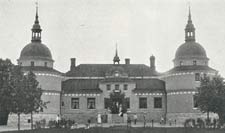
The Sylvan facade |
The face towards the lake had square towers made of wood with high domed roofs
and spires. The whole house was painted red to imitate brick and the towers had
a white decoration of arches between the floors and beneath the roof, similar
to that on Gripsholm.
|
Count Eric von Rosen immediately started a reconstruction of his own after his takeover
in 1900. He had several obvious objections to the Sylvan house. Its centre-section was
overshadowed by the monolithic towers, the upper floors of which were accessible only
through ramparts. The main entrance was crowned by an odd-looking tower, and the windows
were of a kind typical to the 1890th. The architect Ivar Tengbom was contracted to
correct these flaws. He removed the upper floors of the north towers, and had them made
into large balconies overlooking the lake.
|
All decorative elements were executed in carved sandstone and the house was clad
with red bricks. The old centre-section was elevated to incorporate a full
second floor.
|
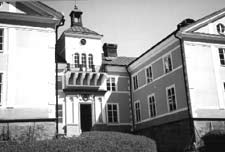
Vibyholms Castle
|
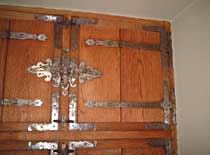
Detail of the beautiful shutters |
The face towards the lake was provided with two long balconies with
parapets, suspended by massive sandstone arches, and with loggias underneath.
All windows were replaced, and are now made of solid oak with antique glass set
in lead, and with decorative wrought-iron hinges. These windows are nearly
identical to some in the Vasa-rooms at Gripsholm. In the 1930ies the
north towers were re-erected, but they now have simple pyramidal roofs and were
left undecorated.
|
The Great Hall
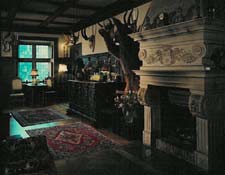
The lower hall |
The great hall at Rockelstad Castle was completed in 1903. It is considered to be
Ivar Tengbom’s first major work, and it is a perfect example of the Vasa-renaissance
style. This Room aims to give the impression of a Roman Atrium, the nexus around which
all other rooms are centred. The upper floor ceiling is elevated, and three large
windows open up towards the lake, to let in the sky-light. The bottom floor has a high
panelling of dark brown pine-wood with arches and pilasters, and a painted decoration
in a mild green, ochre and black.
|
Within each arched field is painted a vase with flowers, unique to each field.
Beneath these arches are rectangular framed fields with painted ornaments in black.
This panelling has its closest counterpart in Duke Charles’ Chamber in Gripsholm Castle,
a room originally decorated in the 1590ies by Master Hans Painter from Strangnas.
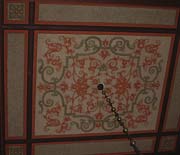

Close-up of ceiling paintings |
The lower floor ceiling has cassettes painted with a primitive pattern that imitates
root-wood or marble. These patterns occur also in the upper floor ceiling, but its
larger fields have intricately composed ornaments in moss-green and English red,
depicting wrought-iron bands and leaf-patterns.
Inspiration of design for this website has mainly been taken from the great hall
and the open fireplace there.
|
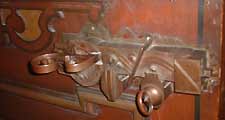 Close-up of door with wrought-iron locks
Close-up of door with wrought-iron locks |
The hall has heavy single doors, decorated as the panelling and with huge
wrought-iron locks. Everywhere in the hall can be found swastikas, count von Rosen’s
personal symbol of luck. The great fireplace, built of nine massive blocks of white
Gotlandian sandstone, is carved with the von Rosen coat of arms and many elaborate
barocco ornaments.
|
The Dining Room
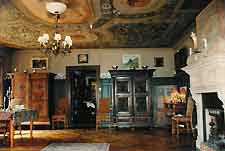
The Dining Room |
The castle dining-room’s
major characteristic is perhaps its small size. It must be noted that this room
was a dining room also in the 17th century building, which was built
to be habitable, and does not have large representative ball-rooms. In the ceiling
are visible the original broad wooden boards, that were decorated with their
remarkable ornaments in the 1680ies. This manner of decorating a ceiling
is called "grisaille", i.e. grey-painting, and it aims to imitate stucco.
|
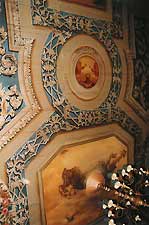
Dining room ceiling |
After the thirty-year-war the upper nobles had a taste for the extravagant barocco
interiors that were fashionable in continental Europe. But the lesser gentry could
often not afford to hire foreign stucco-artists, such as Carlo Carove, but had
simply some skilled local painter make an imitation stucco-ceiling. This eventually
evolved into an established art-form that was exported back to the continent.
The dining-room at Rockelstad has grey acanthus-ornaments on a pale blue background,
and thirteen figurative paintings. The blue colour is very likely secondary.
The octagonal picture in the centre shows Helios riding his sun-carriage; the
surrounding four circular pictures are allegories with descriptive Latin proverbs.
Around these fields is a
band of peculiar ornaments, which show that such patterns of renaissance origin
were still in use this late in the 17th century.
|
|
This room has a fine
fireplace of pink sandstone, with Eric von Rosen’s initials under a count’s crown.
In a corner is placed one of the original 17th century doors,
decorated to match the ceiling.
|

fireplace decor
|
The room has high wooden
panelling, painted green-blue and with accentuating lines of red and
ochre-yellow. This panelling was made at the same time as the adjacent circular
music-chamber, a room decorated in 1890. At that time the old paintings in the
dining-room ceiling were discovered; they had previously been covered with
layers of cloth and paint. The owner, Carl Sylvan, decided to have a similar
ceiling painted in the round room to tie the two rooms together. But at this
modern date the old method with egg-tempera on wood was abandoned, and the
ceiling was painted with oil-paint on a plaster of cement. Consequently this
ceiling has been falling down ever since, for the paint is slowly being dissolved
by the cement.
The Ante-chamber, the Countess bedchamber and the Blue Cabinet
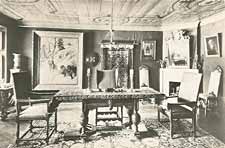
Ante-chamber during the von Rosen era |
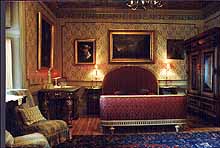
Countess bedchamber |
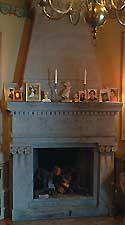
Fireplace in the Countess bedchamber |
These three rooms in the western half of the lower floor all have exquisite
ceiling-paintings in grisaille, similar to those in the dining-room. After a
major water leakage in 1986 these ceilings were renovated, and the conservator
then noted that they had been altered or renovated at least three times before.
It is probable that these ceilings originated at the same time as the one in
the dining-room, and that they have been "improved" upon both before and after
the perhaps 150 years they have been covered with cloth. The Ante-chamber
ceiling has grey ornaments on a pale blue background; the ornaments are bands
of oak-leaves and acanthus around a rectangular centre, the picture of which
has been lost. The Master Bedroom has a greenish-blue oval centre with an
allegoric picture of Hope. This room has a remarkable fireplace of massive
Swedish grey soap-stone, sculpted with gothic roses and a dedication from Eric
to his wife Mary, and the date 1909. The tiny Blue Cabinet has a very
charming ceiling, painted in shades of grey except in its middle, where a blue
sky with woolly clouds opens up.
|
The Book-room
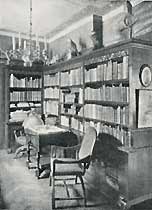
|
The ceiling of this room has a simple band of flowers and leaves in vibrant colours,
and a circular centre, it too with floral patterns. Here is nothing of the grisaille
or stylized barocco ornaments in the other rooms, but more of the renaissance that
has survived in the "kurbits"-patterns common in the County of Dalarna. This ceiling
should consequently be older than the others, perhaps painted as early as mid 17th
century.
This room also has a frieze of Golden Leather tapestry above the high wooden
panelling. This tapestry was manufactured in Holland in around 1700, it is made of
calf-skin decorated with patterns in gold, silver, green and cinnaber. The Book-room
was furnished with its bookcases and panelling by Tengbom for count von Rosen.
|
Counts tower (prev. Billiards)
|
|
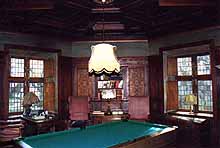
Counts tower
|
This octagonal room in the south-western tower, which has been used as billiards
until 2007 (now guestroom),
was intended as the Count’s personal study, when it was designed by Tengbom.
Again the inspiration was taken from Gripsholm, especially considering the magnificent
so called star-ceiling in the Vasa Hall of that castle, a ceiling that originally
was made for Tynnelso Castle by the German Master carpenter Hans Kantelitz in 1604.
|
The ceiling of the counts tower is made of pine-wood, as well as the high panelling with its
built-in bookcases. All wooden surfaces are painted with minute decorative
wrought-iron like patterns, painted dark against light wood or vice-versa.
These ornaments are fashioned to imitate inlays of different kinds of wood. The
larger sections of the ceiling each have a stylized rose to honour the Lord of
the castle. In the panelling are four sets of built-in and concealed drawers.
Between the panel and the ceiling is a plain section of wall, painted in the
typical indecisive green colour of the renaissance. In one corner is a fire-place
of grey sandstone, adorned with wrought-iron like patterns and sculpted with
portrait-busts of the Count and the Countess on each side.
The Turkish Room
|
Several great estates in Sweden have Turkish rooms or pavilions, often built
to be Smoking-rooms in the 19th
century, but not many are as extravagant as the one at Rockelstad. The room is
in the upper floor of the south-western tower. It was built by Sylvan in 1890
and designed by Claeson, and remains more or less intact today. The blue-prints
reveal that this is not a Turkish style at all, but Moorish, i.e.
North-African. The high frieze, the pillars and the ceiling are decorated with
painted arabesques in red, orange, green, pale blue and gold, and along the
ceiling are eight small vaulted windows with coloured glass. The ornaments have
been painted ‘al fresco’; directly on the wet plaster, and the colours shine as
brightly today as they did a hundred years ago. It is easy to believe that this
is a successful pastiche, but Arabic visitors to Rockelstad claims that the
various patterns actually are made in accordance with Islamic tradition, why
the artist actually could have been an Arab or else he worked according to
detailed models. Count Eric von Rosen much appreciated this exotic room, and in
here he used to sit and play his lute, and often the well-known folk-lore
singer Evert Taube was with him as a welcome guest. Taube composed several of
his finest songs in the Turkish Room.
|
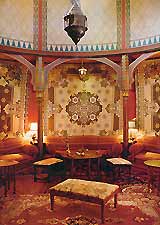
The Turkish Room |
The Chapel of saint Bridget
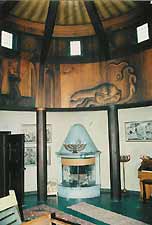
Chapel of saint Bridget |
This room
in the south-eastern tower was first made into a weaving-chamber by Sylvan in
1890. Here the ladies were to retreat for weaving, when the gentlemen had
cognac and cigars in the Turkish room. At that time the room had elaborate
turned pillars with wooden lacework capitals, and the frieze above had been
decorated with murals of lush Sodermanland sceneries. In 1909 countess Mary von
Rosen had this room turned into her personal chapel. The architect Tengbom
installed plain polygonal pillars, covered the friezes and ceiling with
pinewood, and the remaining walls were now of coarse, lime-washed plaster. A
medieval fireplace was made of grey soapstone. The friezes were painted with
the nine revelations of Saint Bridget in thin translucent colours. The artist
was Oscar Brantberg, headmaster of the Royal Academy of Art, and a good friend
of the family von Rosen.
|
The West Wing
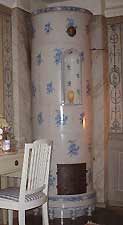
Tile stove in small blue room |
This wing was
transformed into its current appearance at a thorough renovation in the
1920ies, led by Ivar Tengbom. In the lower floor the doors and panelling from
around 1740 were restored, and the rooms were supplied with their attractive
fireplaces in rococo-style from Uppsala-Ekeby.
The log-walls were covered by linen cloth, decorated with fields in warm greyscales
and gracious ornaments in the rococo and classical styles. Broad pinewood boards
became floors in these beautiful, light guest-rooms. The entrance-room has a ceiling
with polychrome renaissance-bands above its floor of green-grey Gotlandian limestone.
The ante-chamber has a ceiling of hand-planed pine-boards that have been varnished
and painted with leaf-ornaments and a picture of the castle as seen from the lake.
|
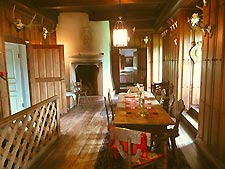
The Hunting-room |
The Hunting-room on the
upper floor is completely made of pinewood, heavy beams carry the ceiling and
all walls are covered with profiled boards, the doors are of a late-medieval
kind with profiled centre-boards. The windows have diamond shaped small panes
set in lead, and they have large wooden indoor covers, decorated with simple
ornaments. Between the windows are a series of cabinets, integrated invisibly
into the panelling. The most dominant piece in this room is however the huge
open fireplace, adorned with the medieval coat of arms of the family von Rosen
and a swastika.
|
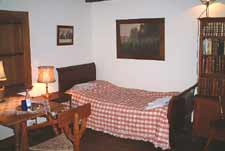
the Gothic Chamber |
In the Gothic Chamber
Eric von Rosen installed a remarkable gothic door of oak, carved with the
characteristic linenfold-pattern of the time. This door, which is preserved
completely in its original state and still has its original wrought iron lock,
was probably made in the 15th century. This room also has a gothic
window with panes set in lead and with extraordinary oak-wood covers and
wrought-iron hinges.
|
|
| |
|


































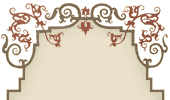







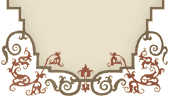
 På Svenska tack
På Svenska tack